|
|
|
|
|
|
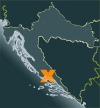 Name:
Split. The Italian name of the city is or better was Spalato.
Name:
Split. The Italian name of the city is or better was Spalato.
Location:
Split is located in the heart of middle Dalmatia, almost exactly between Zadar in the north and →Dubrovnik in
the south. The town itself stretches along the Adriatic Sea. The capital →Zagreb in the north is around 250 km away as the crow flies.
A few kilometres north of Split, the Dinaric Alps run parallel to the coast. Actually there's not much space left between the
mountain range and the sea. Near Split, there are countless islands and islets within sight.
Population: Split has around 190,000 inhabitants. This means that it's the second largest town of Croatia - after Zagreb, of course.
Even today, many descendants of the Romans settle in and around the centre of town.
Orientation:
Split occupies a large peninsula, which is only connected to the mainland by a small corridor in the east. There's a natural harbour stretching
along the southern coast. This port is simply called Gradska Luka (city port),
Next to the port starts the old town. East of the harbour there's the main train station, which is only a few dozen metres away from the
old town. Due to the topography. it was necessary to build a long tunnel below the old town for the railway. The bus terminal and the ferry pier are
conveniently located next to the train station.
The historic city centre, built during the Roman empire, is rectangular and clearly separated from the rest of the city. The old town
and the port are separated by the Obala Hrvatskog Narodnog Preporoda (Croatian National Revival seaside promenade), which
becomes the most vibrant place of Split at night. West of the promenade, the modern pedestrian zone Marmontova starts.
Much further to the west there's the green mountain Marjan occupying the tip of the peninsula. Marjan offers a nice view
not just of the old town but also of the large Luka Poljud (Port Poljud), an industrial and military harbour in the north of Split.
There's also a large stadium used by the local (and quite successful) soccer team. The Dinaric Alps in the north look like a huge, white wall limiting
the space for further urban development.
History:
The history of Split started already more than 1,700 years ago. Around the year 300 AD, the famous emperor
Diocletian decided to spend the last years of his life after retiring in Split - probably because of the beautiful setting.
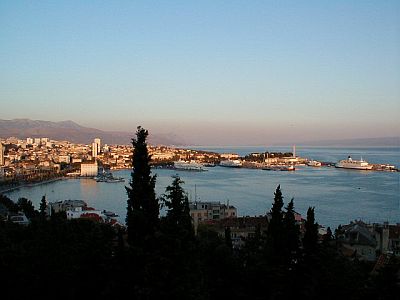
| |
View over Split and the port from Mt Marjan
|
Although Split is by far the biggest town in the area, it never became the capital of Dalmatia. Today, it's one of Croatia's most important industrial
towns and an important transport hub. Since industry and history are clearly separated from each other, it soon became a popular place with tourists.
It also makes a convenient base for exploring the islands near Split. The Diocletian palace is quite unique, and so it was declared World heritage by the
UNESCO in 1979. Additionally, Split is the capital of the province Split-Dalmatia.
Getting there:
Split marks the southern end of the Croatian railway network. Therefore it's easy to get there from →Zagreb.
The trip takes around 8 hours. However, there are only two daily trains, one of them is a night train.
It's also possible to get there by boat, bus and plane. Ferries connect Split with the bigger islands in the vicinity, eg →Brač and
many others. It takes around one hour to get to Brač, the single fare is 19 Kuna. There are also direct ferries running to
→Dubrovnik (three departures a week, 14 hours) and to Ancona in Italy.
Buses run everywhere. There are several daily buses to →Dubrovnik in the south-east.
The trip takes around 4 hours, the fare is 94 Kuna. The route is very scenic and extremely popular, so it's not a bad idea to book ahead in summer.
There are also direct buses to →Mostar and →Sarajevo in
→Bosnia, to →Ljubljana and even to several destinations in Germany, Austria etc.
West of the city there's an international airport. Many charter flights connect Split with some of the major cities in Europe, so it's worth to
check the internet for cheap flights.
|
|
|
|
|
|
|
To put it in short - Split mainly impresses by two things: One is the city with its marvellous historic centre in and around
Diocletian palace itself, the other one is the setting. The turquoise Adriatic Sea with some islands floating on the horizon in front of
the city and the massive limestone wall of the Dinaric Alps in the background are very impressive. This is best viewed from above-mentioned
Mt Marjan or from the area around the train station and the ferry port. The centre of the old town is clearly marked by the
large cathedral (see picture below).
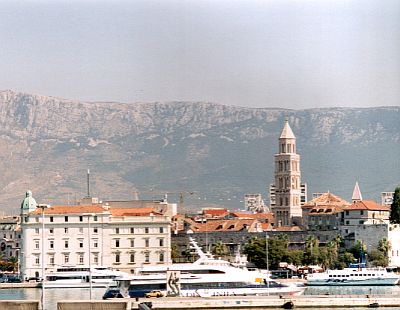
| |
Some ferries, the cathedral and the Dinaric Alps
|
Providing that the weather is fine, a walk to the top of Mt Marjan in the west of Split is highly recommended.
Some more or less small paths lead through the forest to the summit. Actually there are two summits - one features a small funfair and a
tall antenna, the other one a viewing platform giving stunning views over the old town and the harbour, the modern suburbs in the north and
the islands around Split.
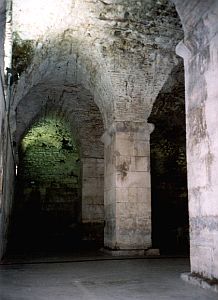
| |
Split: Inside Diocletian-Palace
|
It's impossible to miss the ancient core of the city, namely the Dioklecijanova Palača (Diocletian-Palace).
The palace is protected by very thick walls and some watchtowers at the corners. The rectangular structure is around 215 m long
and 180 metres wide. There are several gates leading inside - among them the Željezna Vrata (Iron Gate) in the west, the
Zlatna vrata (Golden Gate) in the north with a beautiful park in front of it, the
Srebrna vrata (Silver Gate) in the east and the most important one called Gradska vrata (City Gate) leading to
the seaside promenade.
Since limestone dominates the Dinaric Alps, it doesn't come as a surprise that limestone was used as construction material.
Hence, almost everything is very bright. During the centuries, the roads were polished by all the people and vehicles, and so they
reflect the sunlight in a way that makes sunglasses almost compulsory. The middle of the Palace is marked by the central square, which is
surrounded by colonnades. Therefore the square is simply called Peristil (=Colonnade). Logically, the tourist
information can be found here.
Diocletian's palace included the residence of Diocletion himself, a mausoleum, a temple and all the other facilities characterizing a
typical Roman palace. Some parts survived the centuries; they are amazingly well preserved. Other parts were rebuilt, substituted
by newer structures or used for a purpose not intended. Most people enter the palace from the promenade, passing through the
City Gate. Behind the gate is a very large and impressive vault, which was built during the reign of Diocletian, later
buried and eventually excavated. Actually there's nothing inside the vaults (see picture on the right), but the dimension and the
atmosphere are stunning. And - in summer it's a nice place for a rest, since the temperature inside is substantially lower than outside.
Admission fee is 6 Kuna.
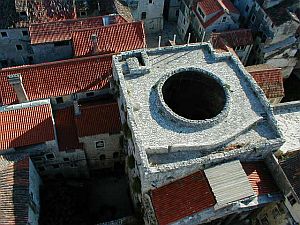
| |
The Vestibule as seen from above
|
It looks like the vault is often used for concerts. Unfortunately there was no concert at the time we stayed in Split, but I
guess the acoustics are overwhelming. From the City Gate, a roofed hallway leads to Peristil square. On the way to
the square, there's the impressive Vestibulum (Entrance Hall, Vestibule) - some sort of open dome
with a round hole in the middle. This structure looks interesting from above, too (see picture on the left). When stepping out of the hallway
onto Peristil, it's worth to look behind. There you will see the fascinating façade of the emperor's residence itself -
perfectly preserved and framed by newer but not disturbing buildings featuring colonnades (for a picture of the palace itself see
→History of Croatia).
Countless Souvenir shops and street cafés line up along Peristil. Prices are comparetively high, but enjoying the
atmosphere while sipping an espresso is priceless. Another fascinating fact about the Diocletian palace is the diversity of
architectural styles: Impressive examples of Romanesque and Roman, Gothic and Renaissance architecture form a unique melange.
It's amazing how much is left of the original palace. Fortunately, Split wasn't attacked during the war from 1991 to 1995.
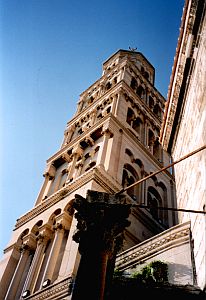
| |
The cathedral in the centre of Split
|
Already from far (see picture at the top) you will notice a tall, white tower called Stolna crkva (Cathedral), which is
a Neo-Romanesque structure. It's possible to climb the tower, admission fee is 5 Kuna, but it's quite tough - the stairways are extremely narrow
compared to the vast number of visitors. The platform atop provides a stunning view over the entire palace and the vicinity.
The city walls surrounding the palace are well preserved, too. The south-east corner of the palace is marked by the so-called
Katedrala, which was built during the reign of Diocletian and originally used as a mausoleum.
Further to the west there's the Sv. Ivan Krstitelj (St Ivan Baptistery) - once used as a Jupiter temple.
Needless to say that there are also countless museums in town giving fascinating insights into the history of Split and Dalmatia. Among them
are the Enthographic Museum, the Archeological Museum, the City Museum, a gallery and many others. It's also worth to explore all the small
lanes inside the palace to experience the unique atmosphere of this town. Although the area of the palace is rather small, it's possible to get
lost for a while. However, the city walls and the central cathedral make it easy to orientate. Of course, countless restaurants and souvenir shops
cater to the visitors.
|
|
|
|
|
|
|
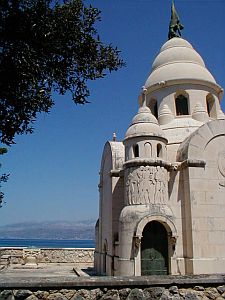
| |
White chapel on Brač island
|
Supetar is a rather small town, and there are some other small towns and villages on the island - connected by an excellent road network.
The island also offers large seaside resorts, especially concentrating along the northern coast. Except for the flat land along the northern coast,
the island is quite mountainous. The highest mountain right in the middle of the island is 780 m high
Vidova gora. There's not much forest left on the island - the landscape is dominated by meadows and bushes.
Brač makes for a nice hiking place. However, don't expect quiet spots at the sea - at least not in summer.
West of Supetar and not very far from the centre, there's a small, white chapel standing next to an old cemetary. The chapel is
rather new, but it looks nice - especially with the sea and the Dinaric Alps in the background. As everywhere in Croatia, the
colour and purity of the sea is amazing. One of the reasons for the beautiful turquoise colour is the omnipresent limestone.
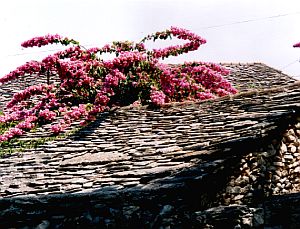
| |
Old, traditional stone cottage in Supetar
|
The centre of Supetar and the touristy, overcrowded stretch along the coast are not very attractive. However, the further you
get away from it, the more interesting it gets. Outside Supetar, there are some interesting, even romantic places with
old stone cottages hidden behind tall hedges, nice gardens and much more. This can be said about other Croatian islands as well:
They offer everything - mass tourism which huge and ugly concrete blocks, small, traditional villages, a breathtaking setting and more.
Exploring the Dalmatian islands is, of course, very time-consuming.
|
|
|
|
|
|
|
There are numerous hotels and pensions in and around Split - just look for the signs hanging out everywhere.
When arriving by train, bus or ferry, some, mostly older, women approach offering private rooms - at least in summer.
Sometimes it's possible to negotiate. It's a good idea to listen to at least two offers and to check the location, because it might be a room far away from it all. One of them is
Prenoćište (=inn) Dragica Bilić. A double in summer will set you back € 30. We were listening to
some other offers, but this was the cheapest. It's a three minutes walk to the palace and to the train station from there. The owner is quite friendly.
Address: Kralja Zvonimira 12, 21000 Split, Tel: 021-554 201
|
|
|
|
|
|
|
www.split.hr
Official website of Split. Nice layout. Croatian and English.
Do you have or do you know a good website about Split? Don't hesitate, let me know!
After checking it, I would love to add it to the link list.
Please note that commercial websites will be declined. For e-mail link see menu on the left.
|
|
| |